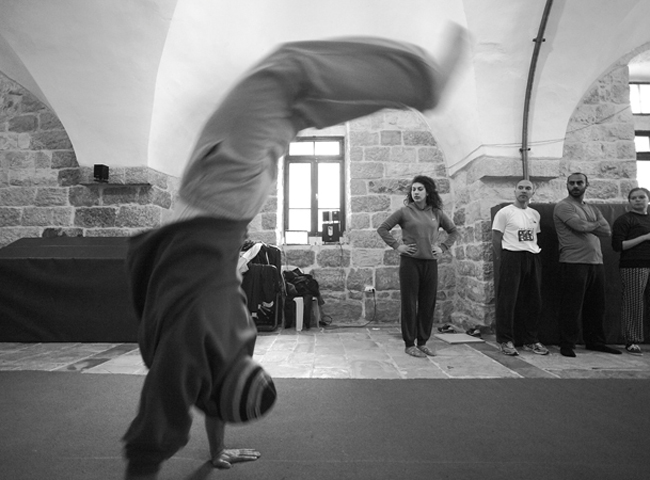‘We have a circus in Palestine’
Palestinian youth are combatting the occupation and conservative social values – through circus.

West Bank – A group of young men carry large barrels down the stairs and roll them across the concrete surface of the courtyard into a large, grey circus tent.
It is the only circus tent in Palestine and belongs to the Palestinian Circus School, located in the small Christian village of Birzeit in the West Bank. The school recently launched its winter semester, with a significant increase in participants: 220 students this year compared with 160 last year. This is largely due to a new programme for 8- to 12-year-olds living in the neighbouring Al Jalazon refugee camp.
The school is based in a renovated old Ottoman style building with thick, yellow, stone walls and vaulted ceilings. In one room are trampolines and mattresses; in another hangs a trapeze, and in the adjacent storage room are shelves filled with colourful juggling clubs and rows of unicycles.
IN PICTURES: ‘Circus behind the Wall’
Today, the young men are preparing for an afternoon practice. Fadi Zmorrod has worked at the school since its establishment in 2006. Initially he did advertisements and public relations, but after being persuaded to join an intense training workshop, he discovered his passion for circus.
“I felt so good,” he told Al Jazeera. “I’d never had this experience of expressing anything physically. When I did circus, I learned a lot about myself.”
From the roof of the school, one can view the neighbouring refugee camp, where the situation for children is “devastating”, noted Jessika Devlieghere, one of the founders of the circus school.
Many people do not know Palestine and what is happening here. It is important to show the world that there is a Palestine and that we have circus here.
“They live crammed together and face much violence on a daily basis. We believe very strongly that this is the heart of our work, because the need for any kind of relief and recreational positive input is bigger then ever,” she told Al Jazeera.
Inside the tent, one man jumps on a trampoline while another balances on a wooden stick between two stacks of barrels. The 33-year-old Zmorrod teaches acrobatics. He believes the reason behind the school’s popularity is that it provides a safe haven for children and teenagers to express themselves.
“Kids have a lot of energy, but there are no healthy places for them to express how they feel – only the street which is dangerous,” he said, noting children are not traditionally heard in this society. The political tension and everyday obstacles presented by the Israeli occupation foster a situation where they are expected to be tough and become adults from a young age, causing frustrations to build up.
“Through circus activities, children can channel their frustration and anger in a positive way,” he said. “The circus school is a place where they are heard and accepted; where they can scream and criticise things. That’s what I teach.”
The Palestinian Circus School not only teaches circus, it also hosts performances. There are no white horses, tamed lions or clowns. Instead the acts are based on acrobatics, dance and skits highlighting political issues related to the Israeli occupation, or aimed at tackling social issues and taboos.
But such themes do not always meet with enthusiasm among the audience.
Zmorrod recalled a show in which he dropped his pants – imitating a common situation faced by Palestinian men of being strip-searched at Israeli checkpoints – and where performers used vulgar language, illustrating the harassment of women in the street.
The show aims to address oppression in different forms by putting a mirror in front of the audience, he explained.
 |
| Circus is a way to encourage young people to question social norms [Rich Wiles/Al Jazeera] |
“These are things that happen all the time but for some guys, who maybe came to see the show with their sisters, it was a culture shock. Two men went outside and asked people from the circus to stop the performance. When they refused, the men went inside and started getting the women to leave,” Zmorrod said.
Circus is viewed as a way to encourage young people to question social norms and conservative cultural values. Though there are more girls than boys in the youngest circus classes, the number drops as they get older.
“Girls stop coming when they are about 13 years old [in some families with conservative values],” Zmorrod said.
One exception is 17-year-old Hazar Azzeh, who joined the Palestinian Circus School seven years ago. Her family supports her and comes to all her performances, she explained, but she knows her situation is unusual and finds it important to be an example for other Palestinian girls.
“I want to show what women can’t do in Palestine, but guys can without facing problems,” she said. “I just want to show them that I’m a girl and I do circus.”
Still, for Azzeh, circus is not only about fighting gender roles. Her 15-year-old brother, who also used to come to the circus school, was seriously wounded after being shot by the Israeli military during a demonstration in the spring. This made her want to use circus as a platform to tell the world about her story, and she was excited to tour European circus festivals this summer.
“Many people do not know Palestine and what is happening here. It is important to show the world that there is a Palestine and that we have circus here,” she said.